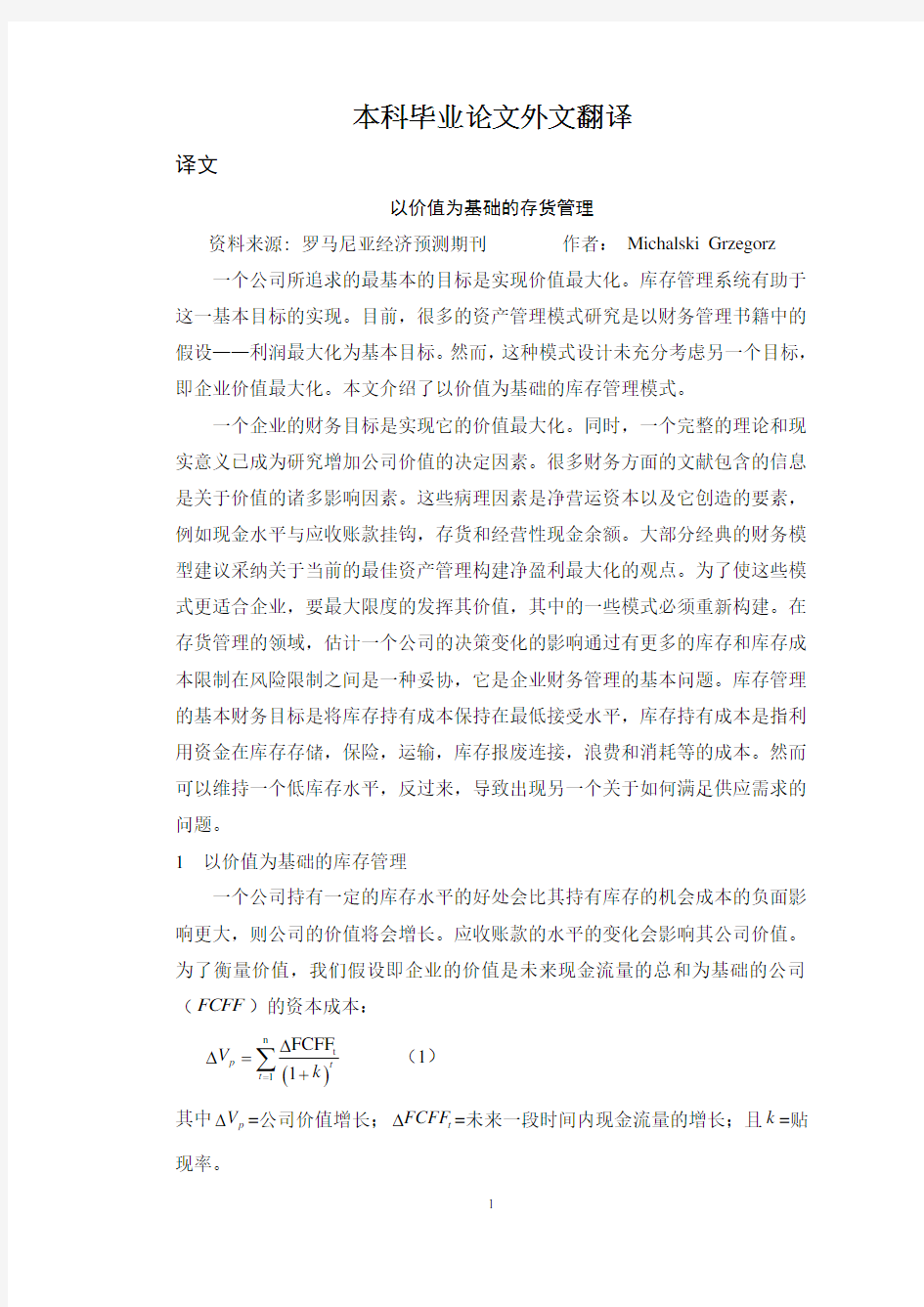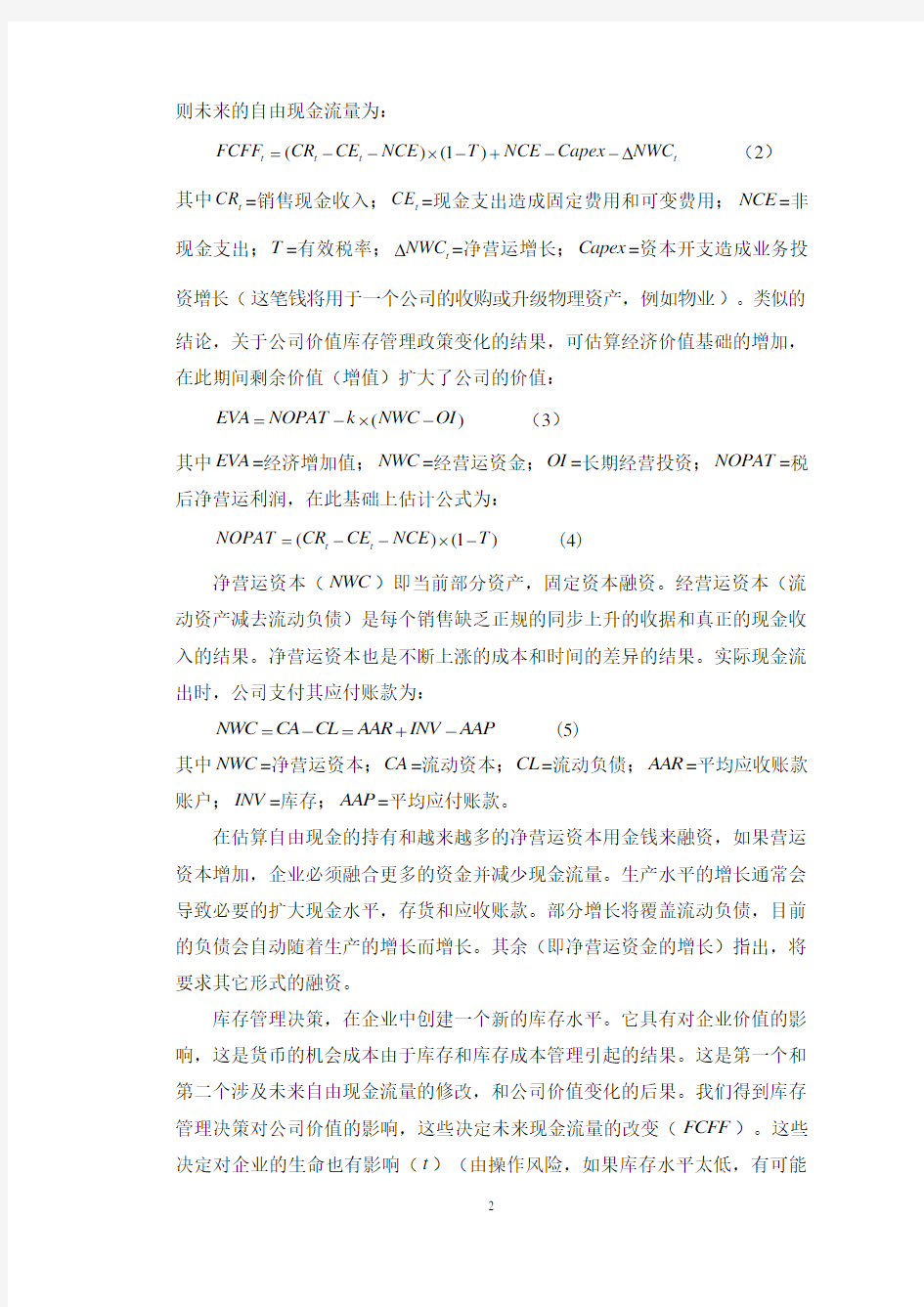

本科毕业论文外文翻译
译文
以价值为基础的存货管理
资料来源: 罗马尼亚经济预测期刊 作者: Michalski Grzegorz 一个公司所追求的最基本的目标是实现价值最大化。库存管理系统有助于这一基本目标的实现。目前,很多的资产管理模式研究是以财务管理书籍中的假设——利润最大化为基本目标。然而,这种模式设计未充分考虑另一个目标,即企业价值最大化。本文介绍了以价值为基础的库存管理模式。
一个企业的财务目标是实现它的价值最大化。同时,一个完整的理论和现实意义已成为研究增加公司价值的决定因素。很多财务方面的文献包含的信息是关于价值的诸多影响因素。这些病理因素是净营运资本以及它创造的要素,例如现金水平与应收账款挂钩,存货和经营性现金余额。大部分经典的财务模型建议采纳关于当前的最佳资产管理构建净盈利最大化的观点。为了使这些模式更适合企业,要最大限度的发挥其价值,其中的一些模式必须重新构建。在存货管理的领域,估计一个公司的决策变化的影响通过有更多的库存和库存成本限制在风险限制之间是一种妥协,它是企业财务管理的基本问题。库存管理的基本财务目标是将库存持有成本保持在最低接受水平,库存持有成本是指利用资金在库存存储,保险,运输,库存报废连接,浪费和消耗等的成本。然而可以维持一个低库存水平,反过来,导致出现另一个关于如何满足供应需求的问题。
1 以价值为基础的库存管理
一个公司持有一定的库存水平的好处会比其持有库存的机会成本的负面影响更大,则公司的价值将会增长。应收账款的水平的变化会影响其公司价值。为了衡量价值,我们假设即企业的价值是未来现金流量的总和为基础的公司(FCFF )的资本成本:
()n t 1FCFF 1p t t V k =??=+∑ (1)
其中p V ?=公司价值增长;t FCFF ?=未来一段时间内现金流量的增长;且k =贴现率。
则未来的自由现金流量为:
()(1)t t t t FCFF CR CE NCE T NCE Capex NWC =--?-+--? (2) 其中t CR =销售现金收入;t CE =现金支出造成固定费用和可变费用;NCE =非现金支出;T =有效税率;t NWC ?=净营运增长;Capex =资本开支造成业务投资增长(这笔钱将用于一个公司的收购或升级物理资产,例如物业)。类似的结论,关于公司价值库存管理政策变化的结果,可估算经济价值基础的增加,在此期间剩余价值(增值)扩大了公司的价值:
()EVA NOPAT k NWC OI =-?- (3)
其中EVA =经济增加值;NWC =经营运资金;OI =长期经营投资;NOPAT =税后净营运利润,在此基础上估计公式为:
()(1)t t NOPAT CR CE NCE T =--?- (4)
净营运资本(NWC )即当前部分资产,固定资本融资。经营运资本(流动资产减去流动负债)是每个销售缺乏正规的同步上升的收据和真正的现金收入的结果。净营运资本也是不断上涨的成本和时间的差异的结果。实际现金流出时,公司支付其应付账款为:
NWC CA CL AAR INV AAP =-=+- (5)
其中NWC =净营运资本;CA =流动资本;CL =流动负债;AAR =平均应收账款账户;INV =库存;AAP =平均应付账款。
在估算自由现金的持有和越来越多的净营运资本用金钱来融资,如果营运资本增加,企业必须融合更多的资金并减少现金流量。生产水平的增长通常会导致必要的扩大现金水平,存货和应收账款。部分增长将覆盖流动负债,目前的负债会自动随着生产的增长而增长。其余(即净营运资金的增长)指出,将要求其它形式的融资。
库存管理决策,在企业中创建一个新的库存水平。它具有对企业价值的影响,这是货币的机会成本由于库存和库存成本管理引起的结果。这是第一个和第二个涉及未来自由现金流量的修改,和公司价值变化的后果。我们得到库存管理决策对公司价值的影响,这些决定未来现金流量的改变(FCFF )。这些决定对企业的生命也有影响(t )(由操作风险,如果库存水平太低,有可能
导致打破生命周期),和融资公司的资本成本率(k )。这三个组成部分的变动对公司创造价值有影响(V n ?)。
库存的变化(造成该公司的库存管理政策的变化)影响净营运资本和一个企业的经营成本的库存管理水平。这些经营成本是由于存储,保险,运输,报废,浪费和库存耗损。
2 EOQ 和 VBEOQ
经济订货批量模型是一个最大限度地提高公司收入和库存成本最小化的模式。
EOQ 模型需要两个方程:
EOQ == (6) 其中,EOQ =经济订货量;P=一定时期内产物/库存的需求;z K =每个订单的成本;u K =在一定时期内每单位的成本;C=持有成本因素;V=每单位的购买成本;
持有成本(u K )是成本平方的结果:
机会成本(库存的附带条件的价格),存储,保险,运输,报废,浪费和耗损成本。
/(/2)z b TCI P Q K Q Z v c =?++?? (7)
其中TCI =存货的总成本;Q =订货量;b Z =最小的存货。
3 POQ 和VBPOQ
生产订单的数量模型POQ 是EOQ 模型的修改,我们可以使用。我们比市场容量可能拥有更多的生产。
POQ 模型可估算如下
:
POQ p m =≤ (8)
其中,POQ =生产订单的数量;z K =生产成本(设置成本);p =需求强度
(每年能卖多少钱);m =每年的最大生产力;C =成本因素。
/21/v /z TCI Q P M C P Q K =?-??+?() (9)
其中Q =生产数量;TCI =存货的总成本。
()/21/INV Q P m =?- (10)
其中INV =平均库存水平。
综上所述,企业财务管理的基本目标是实现业主的财富最大化,存货管理技术必须有助于这一目标的实现。在本文可以看到修改后的以价值为基础的EOQ 模型和以价值为基础的POQ 模型。存货管理的决策是复杂的。高存货服务成本和机会成本造成企业库存负担花费超额现金。相比之下,较高的库存股票有助于增加销售收入,因为正在市场上的客户作出购买决定有更大的灵活性,并且企业也会降低计划外的中断生产风险。尽管最优经济订购量和生产订单仍有问题,但我们可以得到的结论是,这两个修改的以价值为基础的模型有助于管理者在库存管理中作出更为明显的创造价值的决定。
外文文献原文
Value-Based Inventory Management
Material Source: Romanian Journal of Economic Forecasting
Author: Michalski Grzegorz
The basic financial purpose of a firm is to maximize its value. An inventory management system should also contribute to realization of this basic aim. Many current asset management models currently found in financial management literature were constructed with the assumption of book profit maximization as basic aim. However these models could lack what relates toanother aim, i.e., maximization of enterprise value. This article presents amodified value-based inventory management model.
The basic financial aim of an enterprise is maximization of its value. At the same time, a large both theoretical and practical meaning has the research for determinants increasing the firm value.Most financial literature contains information about numerous factors influencing the value. Among those factors is the net working capital and elements creating it, such as the level of cash tied in accounts receivable,inventories and operational cash balances. A large majority of classic financial models proposais, relating to the optimum current assets management, were constructed with net profit maximization in view. In order to make these models more suitable for firms, which want to maximize their value, some of them must be reconstructed. In the sphere of inventory management, the estimation of the influence of changes in a firm's decisions is a compromise between limiting risk by having greater inventory and limiting the costs of inventory. It is the essential problem to the corporate tinancial management.The basic financial inventory management aim is holding the inventory to a minimally acceptable level in relation to its costs. Holding inventory means using capital to tinance inventory and links with inventory storage, insurance, transport,obsolescence, wasting and spoilage costs. However, maintaining a low inventory level can, in turn, lead to other problems with regard to meeting supply demands.
1. Value based inventory management
If advantages from holding inventory on a level defined by the firm will be greater than the negative influence of an opportunity costs from its holding, then the firm's value will grow. Change of the accounts receivable level affects the firm value.To measure that value, we use a formula based on the assumption that the firm value is a sum ot future tree cash flows to firm (FCFF ) discounted by cost of capital financing the firm:
()n t 1FCFF 1p t t V k =??=+∑ (1)
where p V ? = firm value growth; t FCFF ?=future free cash flow growth in period t, and k = discount rate
Future tree cash flow we have as:
()(1)t t t t FCFF CR CE NCE T NCE Capex NWC =--?-+--? (2) where t CR = cash revenues on sales; t CE = cash expenses resulting from fixed and variable eosts in time t;NCE =non cash expenses;T =effective tax rate; NWC ?=net working growth; and Capex = capital expenditure resulting from operational investments growth (money used by a firm to acquire or upgrade physical assets such as property, industrial buildings, or equipment). The similar conclusions, about the results of the change inventory management policy on the firm value, can be estimated on the basis of an economic value added, informing about the size of the residual profit (the added value) enlarged the value of the firm in the period:
()EVA NOPAT k NWC OI =-?- (3)
where EVA = economic value added; NWC = net working capital; OI = long-term operating investments; and NOPAT =let operating profit after taxes, estimated on the basis of the formula:
()(1)t t NOPAT CR CE NCE T =--?- (4)
The net working capital (NWC ) is the part of current assets, financed with fixed capitals. The net working capital (current assets less current liabilities) results
from lack of synchronization of the formal rising receipts and the real cash receipts from each https://www.doczj.com/doc/bf14501110.html, working capital also results from divergence during time of rising costs and time, from the real outflow of cash when a firm pays its accounts payable.
NWC CA CL AAR INV AAP =-=+- (5)
where NWC = net working capital; CA = current assets; CL = current liabilities; AAR =average level of accounts receivables; INV = inventory; G = cash and cash equivalents; and AAP = average level of accounts payables.
During estimation of the free cash flows the holding and increasing of net working capital ties money used for financing. If net working capital increase, the firm musttie much money and it decreasefree eash flows. The productionlevel growth usually causes the necessity of an enlargement ot cash levels, inventories, and accounts receivable. Part of this growth will be covered with current liabilities. For current liabilities also usually automatically grow up together with the qrowth of production.The rest (which is noted as net working capital growth) will require other forms of financing.The inventory management policy decisions, create the new inventory level in a firm. It has the influence on the firm value. It is the result of opportunity costs of money tied in with inventory and generally of costs of inventory managing. 80th the first and the second involve modification of future free cash flows, and inconsequence the firm value changes. We have the influence of inventory management decisions on the firm value. These decisions change the future free cash flows (FCFF ). These decisions could also have influence on the life of the firm (t ) (by the operational risk, which is the result of the possibility to break production cycles if the inventory level is too low), and rate of the cost of capital financing the firm (k ). The changes of these three components have influence on the creation the firm value (p V ?).
Inventory changes (resulting from changes in inventory management policy of the firm) affect the net working capital level and the level of operating costs of inventory management in a firm as wall. These operating costs are result of storage,
insurance, transport, obsolescence, wasting and spoilage of inventory).
2. EOQ and VBEOQ
The Economic Order Quantity Model is a model which maximizes the firm's income trough total inventory cost minimization.
The EOQ
model requires two equations:
EOQ == (6) where EOQ = economic order quantity; P = demand for the product inventory in period; z K = cost per order; u K = holding cost per unit in period;C = holding cost factor; and v = purchase cost per unit. The holding cost factor (u K ) is a result of costs2: Opportunity costs (price of money tied-up in inventory), Storage, insurance, transportation, obsolescence, wasting and spoilage costs
/(/2)z b TCI P Q K Q Z v c =?++?? (7)
where TCI = total costs of inventory; Q = order quantity; and b Z = minimal stock.
3. POQ and VBPOQ
Production order quantity model (POQ ) is the EOQ modification which we can use, when we have grater production possibilities than market capacity.
POQ
could be estimated as:
POQ p m =≤ (8)
where POQ = production order quantity; z K = switch on production cost (setup cost per setup); P = demand intensity (how much we can sell annually); v = cost perunit; m = maximum annual production ability; and C = holding cost factor.
/21/v /z TCI Q P M C P Q K =?-??+?() (9)
where Q= production quantity; and TCI= total costs of inventories.
()
=?-(10)
INV Q P m
/21/
Where INV= average inventory level.
Maximization of the owners' wealth is the basic financial goal in enterprise management. Inventory management techniques must contribute- to this goal. The modifications to both the value-based EOQ model and value-based POQ model may be seen in this article. Inventory management decisions are complex. Excess cash tied up in inventory burdens the enterprise with high costs of inventory service and opportunity costs. By contrast, higher inventory stock helps increase income from sales because customers have greater flexibility in making purchasing decisions and the firm decrease risk of unplanned break of production. Although problems connected with optima' economic order quantity and production order quantity remain,we conclude that value-based modifications implied by these two models will help managers make better value-creating decisions in inventory management.